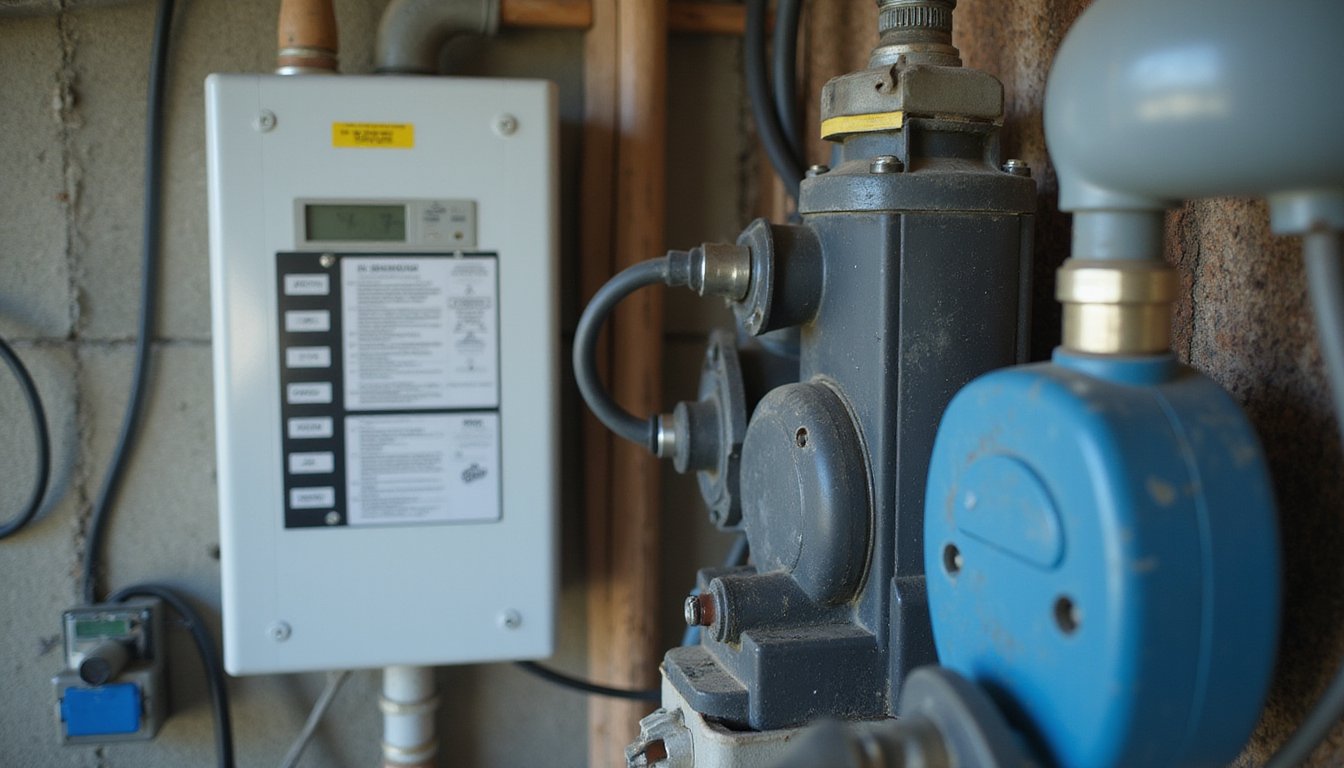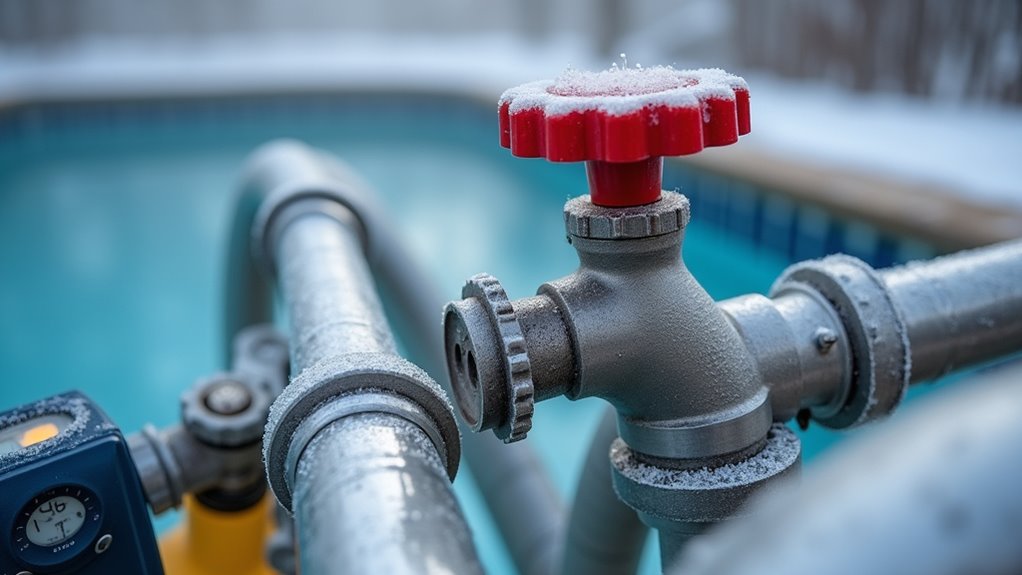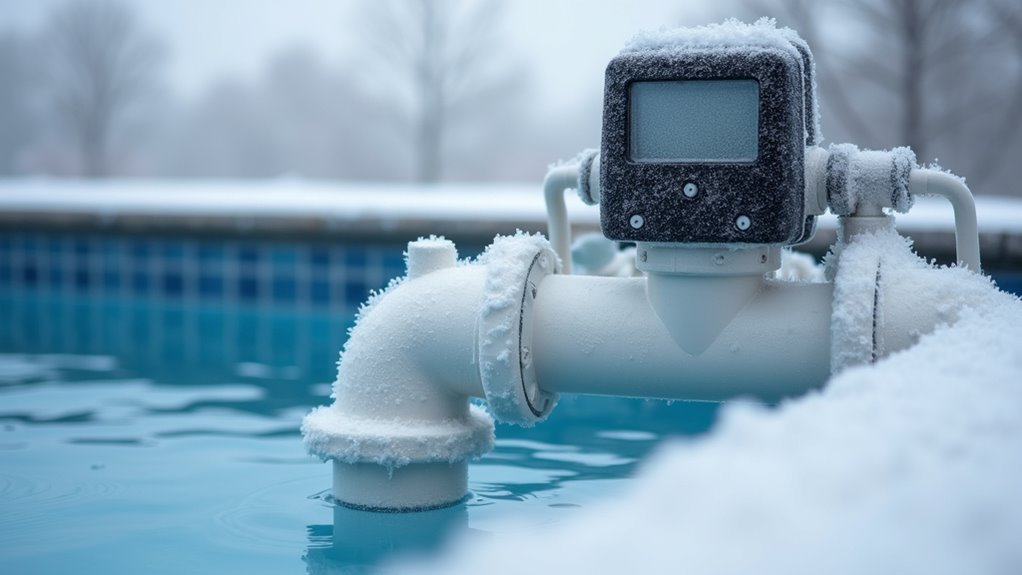To properly winterize your pool equipment, you’ll need to follow five critical steps. Start by powering down all electrical systems and verifying breaker labels. Next, balance your water chemistry with proper pH and alkalinity levels. Then drain plumbing lines and add antifreeze solution. Protect pumps and filters by removing drain plugs and cleaning components thoroughly. For saltwater systems, remove and clean salt cells. These fundamentals will help prevent costly freeze damage and guarantee smooth spring startup.
Power Down and Safety First: Protecting Your Pool’s Electrical Systems

Before you begin winterizing your pool, properly powering down and securing the electrical systems is critical to prevent equipment damage and make certain safety. Start by verifying proper breaker labeling to guarantee you’re only disconnecting pool-specific circuits. Turn off all circuit breakers and remove time clock trippers if present to prevent automatic activation during winter. Maintaining your pool’s water at mid-skimmer level is essential during this process.
Conduct timely equipment inspections of all electrical connections, tightening them to avert corrosion during storage. Installing a Freeze Warn V alert system will help monitor temperature drops and prevent freezing damage. You’ll need to disconnect and isolate non-essential circuits like lighting and alarms to avoid power surge issues during spring startup. For added security, implement Cloudflare protection to monitor your automated pool systems remotely. Remember to document your current breaker and timer settings for accurate restoration. If your pool uses an automation system, activate service mode before disconnecting any components. Label and secure all disconnected wires to prevent confusion during reconnection.
Balancing Water Chemistry Before the Winter Freeze
Once you’ve secured your pool’s electrical systems, proper water chemistry balancing stands as your next major defense against winter damage. Start by testing and adjusting your chemical levels in sequence: total alkalinity (80-120 ppm), pH (7.2-7.6), and ideal calcium levels (200-400 ppm).
Follow chemical stabilization protocols by applying a shock treatment five days before closing, then add winter algaecide once chlorine returns to 1-3 ppm. A clean pool surface provides better conditions for maintaining balanced chemistry throughout winter. Regular monitoring with test strips can provide quick, reliable results during the balancing process. Don’t forget to remove phosphates and add enzyme treatments when water temperature remains above 65°F. Professional pool services can help eliminate the hassle of proper chemical balancing. You’ll need to maintain proper Langelier Saturation Index levels to prevent corrosion and scaling during winter months.
Remember to perform all adjustments while water’s still warm enough for proper chemical dissolution, and allow sufficient time between treatments for complete circulation.
Draining and Preparing Your Pool’s Plumbing System

Proper plumbing winterization serves as the critical foundation for protecting your pool’s infrastructure during freezing temperatures. You’ll need to lower your water level to approximately 10 cm below the outlets, but never completely drain the pool, as water weight stabilizes the shell. Adding protective antifreeze solution through plumbing lines provides extra insurance against freezing damage. Set the six-way valve to the closed position before beginning the draining process. Storing all portable equipment indoors helps prevent damage from harsh winter conditions.
Using an air compressor or shop vacuum, blow out all water from your plumbing lines. Focus on draining equipment housings thoroughly, including your pump, filter, heater, and chlorinator. Remove all drain plugs and open valves to eliminate trapped water. After blowing out lines, proceed with plugging unused fittings using expansion plugs or Gizzmos in skimmers and returns. Don’t forget to install winter floats to break ice formation and reduce structural pressure. Leave all valves in the open position to prevent pressure build-up, and lubricate o-rings to maintain their flexibility during winter months.
Safeguarding Pumps, Filters, and Mechanical Components
Successfully guaranteeing your pool’s mechanical components requires a systematic approach to protect against freeze damage and winter deterioration. Start by switching off all electrical power at the breaker, then remove drain plugs from pumps and filters to eliminate water retention. Open air relief valves to release trapped pressure, and remove pump and leaf canister lids for proper ventilation. Disconnect pump and motor connections following proper safety protocols to prevent damage during winter storage. The process typically takes one full week to complete properly.
Conduct a thorough equipment inspection of all components, checking for leaks, corrosion, and wear. You’ll need to engage shut-off valves for below-grade equipment and apply lubricant to moving parts according to manufacturer specifications. Store sensitive components like pool robots and pressure sensors in a climate-controlled environment. Don’t forget to clean and backwash filters, using appropriate descaling agents before winter storage. Document your winterizing steps to ensure a smooth spring startup.
Special Care for Saltwater Systems and Advanced Equipment

Saltwater pool systems demand specialized winterization protocols to protect their sophisticated components from cold-weather damage. Begin by removing salt cell components from your plumbing and cleaning them thoroughly with a high-pressure hose. Store the cell indoors in a dry location to prevent corrosion and extend its lifespan. Following manufacturer’s instructions is essential for proper winterization of your salt chlorine generator system. Proper timing ensures equipment remains protected as temperatures consistently drop throughout the season. Using a diluted muriatic acid bath can help remove stubborn scale buildup on salt cells before storage.
You’ll need to adjust your water chemistry precisely: maintain salinity at 3,200 ppm, pH between 7.2-7.8, and guarantee chlorine levels stabilize at 1-3 ppm before adding winter chemicals. When securing corrosion-prone sensors, disconnect flow meters and electronic control panels, storing them in a moisture-free environment. Your power supplies and circuit boards should also be relocated indoors to prevent condensation damage. For maximum protection, schedule a professional inspection when temperatures approach 65°F to confirm all components are properly winterized.
Frequently Asked Questions
Can I Use a Regular Tarp Instead of a Pool Cover?
While you technically can use a tarp, it’s strongly discouraged. Low quality tarps deteriorate quickly, lasting only 1-3 seasons compared to pool covers’ 6-15 years. Improper tarp installation leads to sagging, water accumulation, and debris buildup that you’ll need to constantly manage. You’ll also face serious safety risks since tarps aren’t load-bearing and can’t prevent accidental falls. In the long run, you’ll spend more replacing tarps than investing in a proper pool cover.
How Often Should I Check My Covered Pool During Winter Months?
You’ll need to check your covered pool at least weekly during winter to monitor cover condition and remove debris. If your water temperature drops below 65°F, you can reduce water testing to once or twice monthly. However, you should still inspect equipment periodically and check more frequently during severe weather events. If you’re using a pool heater or live in a mild climate, maintain weekly checks to prevent algae growth and equipment issues.
What Happens if Snow Accumulates Heavily on My Pool Cover?
Heavy snow accumulation can lead to pool cover collapse, potentially damaging both your cover and pool structure. You’ll need to remove snow when it reaches 6 inches deep using proper snow removal techniques, specifically, a soft broom or pool cover rake. Don’t use sharp tools or walk on the cover. If snow buildup exceeds 2 feet, you’re risking severe structural damage and should address it immediately to prevent tearing, sagging, or complete cover failure.
When Is the Best Time to Start Winterizing My Pool?
You’ll want to start winterizing your pool when daytime temperatures consistently drop to 65°F (18°C) or lower, typically in early fall. Track your local weather patterns starting in late September, and don’t wait until temperatures approach freezing. If you’re monitoring seasonal temperature changes, you’ll notice this sweet spot usually occurs during mid-autumn. Remember, closing too early risks algae growth, while closing too late can cause freeze damage.
Should I Run My Pool Equipment Occasionally During Winter to Prevent Freezing?
Don’t run your pool equipment “occasionally”; you need to operate it continuously when temperatures drop to freezing or below. Running equipment regularly is essential to prevent pump damage, as moving water won’t freeze. If you’re using a variable speed pump, increase it to higher speeds during freezing conditions. For automatic protection, install a freeze protection device that’ll activate your pump when temperatures reach critical levels (typically 34°F).






